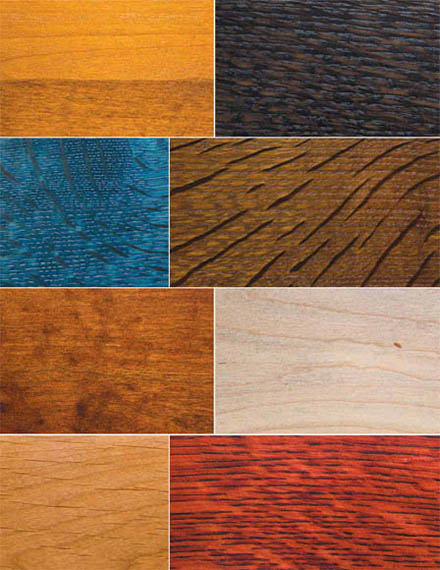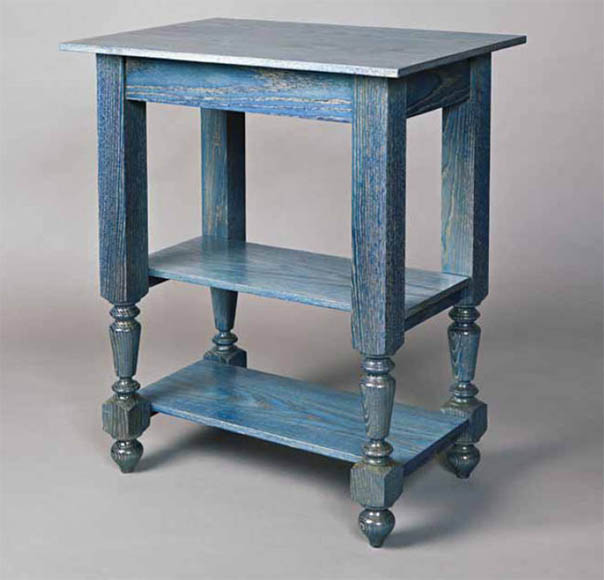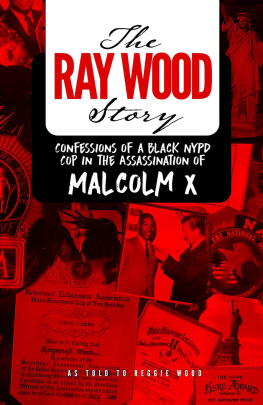THE ART OF
COLORING
WOOD

The Art of
COLORING
WOOD
A WOODWORKERS GUIDE
TO UNDERSTANDING DYES AND CHEMICALS
BRIAN MILLER
MARCI CRESTANI


Contents
The Art of Coloring Wood
A Woodworkers Guide to Understanding Dyes and Chemicals
by Brian Miller and Marci Crestani
All rights reserved. No part of this book may be reproduced or transmitted in any form or by any means, electronic or mechanical, including photocopying, recording, or by an information storage and retrieval system, without written permission from the publisher.
Brian Miller and Marci Crestani 2017
All photos are courtesy of Marc Carter, except for , which are courtesy of Fred Siegel.
Graphic design by Maura J. Zimmer.
ISBN: 978-1-61035-305-2
135798642
Linden Publishing titles may be purchased in quantity at special discounts for educational, business, or promotional use. To inquire about discount pricing, please refer to the contact information below. For permission to use any portion of this book for academic purposes, please contact the Copyright Clearance Center at www.copyright.com.
Printed in the United States of America
Library of Congress Cataloging-in-Publication data on file.
The Woodworkers Library
Linden Publishing, Inc.
2006 S. Mary
Fresno, CA 93721
www.lindenpub.com
The authors are deeply grateful to Marc Carter for his professional photography featured in this book and to George Frank for his inspirational book Classic Wood Finishing. We are also indebted to Fred Siegel for his wonderful additional photography.
Together the authors would like to thank:
Pam Goldman
Tony Fortner
Gene Leslie
Nicholas Crestani
German Lucero
Sam Millard
Lilly Plasencia
Carl Stammerjohn
Camerino Velazquez
Arlen Heginbotham, Conservator,
Decorative Arts and Sculpture, Getty Museum
Brian Miller would like to thank:
Tom Montgomery
Scott Goldstein and Lauren Gabor
Jim Ipekjian
Randell Makinson
Harvey and Ellen Knell
Zach and Denise Snyder
Harry Anderson
David Zander
Mark and Phaedra Ledbetter
Michael Schneickert and Karen Otamura
Joe Pytka
and last but certainly not least, his wife Nancy for all of her support.
Marci Slade Crestani would like to thank:
Dale Pryzbal of Woodfinishing Enterprises
Sue Ann Chui, Assistant Conservator of Paintings at the J. Paul Getty Museum
The Research Library staff at the Getty Research Institute
Don Williams, retired Senior Furniture Conservator at the Smithsonian
and most especially her husband Bob for his unflagging patience and good humor.
Critical Warnings to Read and Heed Before You Begin!
Most chemicals presented in this book are poisonous and/or carcinogenic if ingested and/or inhaled. Take care to keep all chemicals from contact with bare skin and clothing.
Cautionary Notes:
- ALWAYS wear gloves, eye protection and a respirator mask when handling chemicals.
- NEVER use chemicals to color any wood that will be used in food preparation or serving, such as cutting boards, salad bowls or serving utensils.
- ALWAYS thoroughly clean your work surface after working with chemicals.
- ALWAYS properly dispose of your chemicals and solutions under the guidance of your local waste management or environmental agency.
- NEVER mix chemicals at the same time in the same container within the same solution. Each chemical should always be formulated in its own solution in its own container. If you want to use more than one chemical to color your wood, make up a solution of the first chemical, apply it and let it dry. Then make up a separate solution in a clean container for the second chemical and apply it.
- NEVER SPRAY CHEMICALS. Always apply chemicals with a brush or sponge.
- ALWAYS properly store your chemicals in non-reactive containers (such as glass or plastic) in a dark, cool location.
- ALWAYS KEEP CHEMICALS OUT OF THE REACH OF CHILDREN!
One Final Note:
The most efficient (and least confusing) way to research the potential health, safety, environmental and reactivity risks of a particular chemical is to look up its MSDS (Material Safety Data Sheet) or its SDS (Safety Data Sheet). It is much more efficient to search by the chemicals precise name than to search the internet under the broad category of SDS for Chemicals. Many of the latter sites require a subscription or are very easy to get lost in!
So for example, if you are interested in using potassium dichromate, search SDS for potassium dichromate. And by reading through several of the results pages, you should gain an understanding of the risks involved. This book shows you the rewards.
Introduction: Why Color Wood?
For centuries, wood has been colored with chemicals and dyes. The question is: Why? The answer has remained the same: Chemicals and dyes enhance the color of wood and impart a deeper aged richness by accentuating the grain pattern in a way that stains and clear coat finishes do not.
As you will notice throughout this book, we refer to the process of coloring wood.
If there is only one thing that you take away from this book, we hope it is this: that you no longer use the words dye and stain interchangeably! They are two separate processes with two separate results. The one thing they share in common is that they both color wood... but with quite different effects. Chemicals and dyes color the fibers of the wood without leaving a residue. Light is able to travel into the wood and reflect back, revealing the grain pattern with a great degree of clarity. Stains deposit pigments into the pores of the wood and trap the light, which obscures the grain pattern.

Woodworker Lilly Plasencia wanted to do something outside of her comfort zone by trying some of the techniques she learned in Brians finishing class. Her oak table is spray-dyed with Arti-Dye #138 blue and then grain-filled (highlighted) with gold Cres-Lite metallic powder.

The base of Marci Slade Crestanis table is actually made of maple dyed a deep brown color. She wanted the durability, weight and quiet grain pattern of hard maple but preferred a darker colored wood base to highlight the quilted maple top.
To illustrate the difference in terminology, its as if you ask someone what they are cooking for dinner, and they say, Im going to boil some steaks. Then you ask someone else, and they tell you, Im going to grill some steaks. Both steaks are cooked. But the flavor and appearance between the two is very different. So it is with coloring your wood with chemicals and dyes versus coloring your wood with stains. Chemicals and dyes improve the flavor of the wood without masking it as stains do.
Next page













